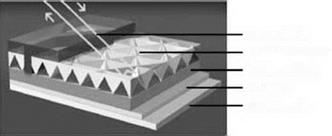Within the EU, more than 40 000 lives are lost in traffic accidents each year, and some 9000 people are injured each day. Traffic accidents are the most common cause of death for those aged below 45 years, and cause more casualties than either heart disease or cancer. The financial burden is estimated at D160 billion every year, which is more than 2% of the gross domestic product of the EU.
During the 1930s, at a customer’s suggestion, Harry Heltzer, the future President of the US company 3M, was assigned to a new project to develop a self-adhesive reflective material for use on highways to make the center marking on highways more reflective at night than was possible with the standard white or yellow paint. The
 Deckschicht
Deckschicht
Reflexionsschicht
Tragerschicht
Klebstoff
Schutzpapier
Figure 8.71 Structure of a self-adhesive reflecting foil made from microprisms.
solution was a pavement-marking tape coated with tiny glass beads that was also suited for use on traffic signs. The first retroreflecting traffic signs with the new reflective sheeting were installed in Minneapolis (Minnesota) in 1939.
Subsequently, a wide variety of self-adhesive retroreflecting products were developed that rapidly conquered the market. With the increase in mobility and private car use throughout the world, traffic safety needs also increased, and for many decades retro — reflecting materials have contributed substantially to making the roads a safer place. Shortly afterwards, not only traffic signs but also license plates, town signs and street name signs, were provided with self-adhesive reflective sheeting. Today, retroreflecting contour marking represents a new trend in the rear and side marking of trucks.
For many years, ‘be seen, be safe’ has also been the motto in the leisure and professional clothing sector. From schoolchildren to sportspersons, roadmen or firefighters, reflective elements applied to clothes and accessories have become widely accepted as enhancing not only safety, but also design and visual appearance.
In extremely dangerous situations, for example in the case of accidents at sea, visibility is a matter of life and death. The provision of lifesaving equipment with reflective material substantially increases the chances of being rescued in case of wreckage, even at night and regardless of the weather.
The development of microreplication, a trendsetting technology, has further enhanced the performance of reflective materials in recent years. Here, a structured surface composed of tiny, identical microprisms with substantially higher reflection values than traditional reflective materials, replaces the glass beads (Figure 8.71).
8.12.1
 10 января, 2016
10 января, 2016  Pokraskin
Pokraskin  Опубликовано в рубрике
Опубликовано в рубрике 